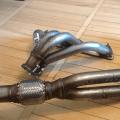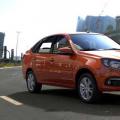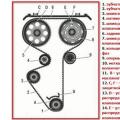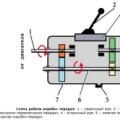In 2008, the Audi R8 became the world's first production car with full LED headlights, followed by innovative dynamic direction indicators in 2012. New chapter in the history of the automotive industry was opened by Audi in 2013, when on the updated audi models The A8 now has Matrix LED headlights. Now, the brand with four rings on the Audi R8 LMX is showing a laser emitter that creates a high beam. This technology improves the illumination distance, which is perfect solution for the sports car Audi R8 LMX.
In the development of lighting technologies, Audi engineers work together with colleagues from sports division... For example, the combination of LED and laser sources to form the high beam will be used for the first time on the new racing prototypes of the Audi R18 e-tron quattro during the 24 Hours of Le Mans marathon on 14-15 June. This continues the tradition of the brand with four rings: sporting events become a testing ground for new technologies for use in production vehicles.
In a laser high beam, the laser module emits a beam of light that hits twice as far as led headlights... Each module contains four high power laser diodes. With a diameter of only 300 micrometers, they generate a blue laser beam with a wavelength of 450 nanometers. A phosphoric converter converts this radiation into usable radiation road traffic white light with a color temperature of 5500 Kelvin, creating ideal conditions for perception by the human eye.
It allows the driver to perceive contrasting details more easily and prevents fatigue. The light beam, which is activated from speeds of 60 km / h, complements the LED high beam modules of the Audi R8 LMX and significantly increases visibility and safety. An intelligent system with a video camera monitors the presence of other road users and automatically adjusts the distribution of the light flux, eliminating the possibility of dazzle.
Audi R8 is the flagship sports model, close in design to racing cars... The Audi R8 LMX is offered as a coupe and will be limited to 99 pieces. With a power of 570 hp and developing 540 Nm of torque, its 5.2-liter V10 engine can accelerate from 0 to 100 km / h in just 3.4 seconds.
The new flagship model is eye-catching with an exclusive paint finish - Ara Blue with crystal effect. A large, fixed geometry rear spoiler increases downforce on the rear axle. It is made of CFRP with a matte finish. The lower front spoiler, side air intakes, cover are made of the same material. engine compartment, exterior mirror housings, side skirts, rear wing and diffuser.
The folding sports seats are finished in fine Nappa leather with Sepang Blue diamond stitching. The harmony of the interior is emphasized by light touches. In the decoration of the central tunnel and the lever parking brake used matte carbon.
The Audi R8 LMX will hit European roads in the summer of 2014. In Germany, prices will start at 210,000 euros. The quota for Russia is limited to a few cars, the price will be announced at the start of sales - in the 4th quarter of 2014.
True, here BMW is challenging Audi's leadership in "laserization". You can understand the Munich people: the Vision ConnectedDrive concept roadster, equipped with laser optics, debuted back in 2011 at the Geneva Motor Show. In addition, sales of a serial BMW with progressive high beam - advanced "spotlights" will be installed as an option on the i8 hybrid sports car. The car is planned for sale in Russia and will be shown at the Moscow Motor Show.
Automotive light evolves in well-established directions that rarely change. Today, LED optics are of particular interest to most drivers. It has a lot of advantages that do not allow alternative solutions to approach this segment. Nevertheless, technological developments do not stand still, a completely different concept of light supply is gradually gaining popularity. These are laser headlights that have brought fundamentally new qualities to the organization of optical support of a modern car.
How laser optics work
Whereas traditional automotive light sources such as incandescent lamps and standard LEDs provide somewhat dynamic radiation, the laser produces monochrome and coherent scattering. This is largely due to the advantages of the technology. Despite this, the design is also based on diodes, due to which the laser headlights function. The principle of operation of such optics is based on the fact that the laser is not a source of illumination, but an element of energy supply. Three phosphorus-containing LEDs are still responsible for the light. It is this group, supported by a laser, that forms a light beam with the required parameters.
In the process of operation of any headlights, the atoms of the active substance consume energy, giving off photons at the output. In particular, the classic incandescent lamp contains a tungsten filament that emits light as it heats up from electricity. The change in the configuration of energy consumption has led to the fact that the laser headlights of the head light can provide power that is tens of times higher than the potential

Positive feedback on laser headlights
New technology provides several benefits at once automotive optics... As already noted, even with modern xenon, such a headlight will benefit from power. And the consumer confirms this. So, the practice of use suggests that the power of the laser system is several times higher than that of traditional halogens and LEDs. More accurate calculations indicate that the laser headlights are capable of 600 m forward. For comparison, the maximum potential of a conventional high beam in best case reaches 400 m.
But the main advantage of laser light is not even in the basic working qualities. Thanks to its special operating principle, such a source facilitated the control of the light beam. Few users in particular were able to try the latest system intelligent control of dynamic laser light. However, according to experts, this direction of development of optics promises a lot of new opportunities. Suffice it to say that in latest models German cars laser focuses on the possibility of spot beam delivery. Thus, the system automatically monitors danger zones, focusing the driver's attention on them.

Negative reviews
The obvious advantages still do not exclude the negative aspects of the operation of laser headlights. The disadvantages are caused by the same features that LEDs have. So, users note that in some situations the light is too blind to oncoming drivers and, in general, it is unusual, which can distract other motorists. In addition, in existing versions, laser headlights are very expensive and this important point, considering that their dignity is not always vital.
Manufacturers
There are two categories of laser headlight manufacturers. On the one hand, such technologies are quite naturally mastered directly by car manufacturers. The most successful developments in the segment demonstrate audi and BMW. True, in mass models, laser optics rarely appears so far - such equipment is more often acquired as an optional solution. And on the other hand, laser headlights are produced by advanced LED technology developers. We can note the firms Philips, Osram and Hella, which occupy leading positions in the design of the newest. What is especially interesting, in both categories, companies occupy highly specialized niches, promoting unique technological solutions.

How to make laser headlights with your own hands?
There can be no talk of a full-fledged production of a laser headlight with the above-mentioned characteristics, however, partial introduction of diodes of this type into automotive optics can give some positive result. So, many home craftsmen offer a technique for making a laser pointer for a headlight, which will be based on a diode from a DVD-RW drive. The laser is integrated into the brake light recess or with beam correction by cold welding. To limit the length of the stream, you can use a stencil that will repeat the shape of the desired beam. Therefore, even before starting production, you should decide on what characteristics laser headlights should have. With your own hands, the correction base can be made of cardboard, leaving the window suitable size... Usually, headlights are made at the rate of a beam of 1.5 m, provided that a 4-meter projection is provided.
Conclusion

In various areas of technological improvement of cars, processes of active implementation of intelligent systems are taking place. Optical configuration, even in modern generations, is designed with great emphasis on providing basic light transmission characteristics. Optimum radiation properties have already been achieved with standard LEDs. In turn, laser headlights along with an increase in performance optics also allowed developers to master new principles of light control. Not yet in mass productionbut with examples of concept cars, leading companies are showing impressive examples of laser headlight automation. According to experts, work in this direction should not only improve the interaction of the driver with the headlights, but also generally improve the ergonomics of machine control and the level of safety.
Laser headlights - high-tech light optics, which is on the wish list of all advanced motorists. Everyone knows that these devices protect drivers from accidents and are quite convenient in foggy times, but they also have some disadvantages. More on this below.
[Hide]
Laser light optics device
A relatively new device that appeared in 2014, but has already won the persistent and ardent love of drivers - the laser anti-fog headlight... They are installed depending on head optics or side lights.
You can often find them behind the car, and the choice of installation is extensive:
- under the bumper of the car;
- behind the car directly under the spoiler;
- under or on the bottom of the machine.
The great thing about laser lights is that they are visible to cars driving behind in any weather. It is worth stopping and the devices leave a bright red stripe that breaks through the fog and is perfectly visible through the rain, thereby telling the drivers of cars driving behind them that they should also slow down and keep their distance.
The device is small enough, and therefore almost invisible, to worry about how harmonious the device will look on the car.
Principle of operation
This device is based on. The main task of such a headlamp is that no precipitation falls on it, because the optics are in an uncomfortable position - below the fog line.
The principle of operation of laser headlights is exactly the same: they can be said to take into account the location of the frost. The light falls directly on the road as a red stripe, signaling to the rest of the drivers. Despite the fact that LEDs act as light, thanks to which the laser works, the headlights are not a source of illumination, but an element of energy supply.
No matter what the headlight is, inside it the atoms of the active substance consume a certain amount of energy, converting it into photons. For example, an incandescent lamp device has a tungsten filament that emits light when heated. This principle has been modified and transformed. Laser lights can provide a power that is several times higher than the power of basic xenon lamps (video by Techno Drive).
Advantages and disadvantages of using
The advantages are obvious:
- Compared to a conventional device, the energy costs will be the same, but the brightness of the laser lamp will be much higher.
- The prototype laser lights for the BMW model produce a luminous intensity of 1.7-1.8 more, given that the power is 50% lower than that of conventional devices.
- This optics is created using high tech, and therefore its "visibility" is not only clearer, but also further, in comparison with xenon headlights.
- The optics contains microcontrollers that limit the direction of the light beam. This mechanism protects other drivers from interference.
Despite the fact that there are a lot of advantages, there are also disadvantages, as in any technical equipment... The obvious drawback is the price. To afford such optics, you need to earn good money. Besides, not every car really needs such "bells and whistles". Another drawback is that it is almost impossible to make such a device with your own hands.
Manufacturers
These devices are produced directly by car manufacturers. As mentioned above - for example, bMW company and Audi. The installation is still an operational solution, since it is rarely present in mass-produced cars. Developers of LED technology, including Philips, also act as a manufacturer.
How to make laser headlights yourself?
It was said just above that it is almost impossible to make such high-quality optics, but hope dies last. As a device, you can use the partial introduction of diodes into automotive optics. This will give some result.
Some car enthusiasts are pushing their own techniques where they use a diode from the drive of a DVD-RW player to make the device. In this case, the device is installed in a niche for a fog light or a brake light. After that, the structure is welded, due to which the beam is corrected thanks to a stencil cut from cardboard. Before starting this painstaking work, it is necessary to determine the characteristics of the lanterns.
Conclusion
In conclusion, we can say that although it is currently problematic to purchase them, and it is difficult to make laser headlights with your own hands, you should not neglect the last point. Redesigned headlights will also reduce the risk of driving at night and in foggy times.
A laser headlight for a car is a great solution. Despite the fact that not all drivers are aware of this innovation and may be surprised. In any case, this will save the car from a collision.
It is imperative to remember that the angle of inclination of the cylinder must be carefully adjusted. Otherwise, when driving over a hill, the light strip will fall exactly on windshield behind the vehicle.
"aroused admiration and respect from others, and even more so. It would seem that everything has already been invented and there is nowhere else to develop automotive optics, but the creators of laser headlights do not think so ...
LED headlights, like any other revolutionary headlights for their time, before the advent of laser headlights, were considered the most effective source of lighting, which automakers actively use in their cars to this day. By the way, not all auto giants can afford serial production today, as a rule, premium segment cars are equipped with such headlights.
With laser headlights, it is still more complicated and confusing, these headlights are an achievement of high technology, and for their creation it is necessary special conditions and many different electronics, which actually creates laser ray... Leading manufacturers of automotive light optics such as Osram, Philips, Valeo, Bosch and Hella are actively working in this area.
In addition to the leading manufacturers of laser headlights, car manufacturers are very interested. So in 2011, laser headlights were presented by BMW, which demonstrated its own achievements in this area on its concept, codenamed i8. Anyone who follows the events at BMW remembers how a few years later the concept turned into a full-fledged production supercar.
Laser headlights BMW i8 video
A few more years later, such headlights began to appear on other BMW models. The BMW laser module was developed by the engineers at Osram. Despite the high cost of the technology itself, as well as the cost of components and developments, laser headlights received the approval of the management, which was not even embarrassed by the fact that the presence of laser headlights would significantly affect the final cost of the entire car. More important for developers and project managers was leadership in this area, as well as the advantage that the buyer will receive after purchasing their offspring.
The second auto giant Audi is no less active in the "laser direction". The Audi R18 E-Tron Quattro and the Audi Sport Quattro Laserlight concept have received laser headlights for the first time. A characteristic feature of the Audi laser headlights is that the laser modules are activated at a speed of 60 km / h and above. Up to this point, the road is lit by "ordinary" ones.
Laser headlight manufactured by Audi consists of four powerful laser diodes, their glow body diameter is equal to 300 micrometers. These diodes are capable of generating a light beam of blue color with a wavelength of the order of 450 nm. Thanks to a special fluorescent converter, the blue light turns into white (color temperature 5500 K). According to manufacturers, such light is the most pleasant for the eyes and practically does not cause fatigue. The length of the light beam itself is about 500 meters.
Unlike our usual light sources (incandescent lamps, gas discharge lamps, LEDs) laser headlights have many "pluses". It all starts with the fact that the laser radiation is monochrome and coherent, in other words, the waves are constantly of the same length with a constant phase difference.
We list the advantages of laser headlights
- This allows you to form a beam of light that is very close in nature to a parallel one (makes it possible to illuminate a specific area).

- The laser beam is ten strong compared to halogens as well. The length of the laser beam reaches 600 meters, while the usual high beam boasts only 200-300 meters (and the nearest one is even worse than only 60-85 meters).
- Laser headlights do not dazzle as xenon, since the light beam is directed strictly to the point that needs to be refreshed. If a living creature, for example, a person, enters the illumination area, some of the diodes will immediately turn off and illuminate everything except the area in which the living object is located.
- Laser headlights have 30% less power consumption than classic counterparts.
- Compactness is another "plus" in favor of laser headlights, they can rightfully be called the most compact of all existing ones. The light-emitting area of \u200b\u200ba laser diode is one hundred times smaller than a conventional LED, in this regard, with the same light output, a laser headlight requires a reflector measuring only 30 mm in diameter (for comparison, xenon has 70 mm, and halogens generally have 120 mm). Such capabilities of laser headlights allowed engineers to significantly reduce the size of headlights without losing, but on the contrary, adding lighting efficiency.
A few words about how it works
The laser head light will work in close interaction with the computer, which, guided by the data from the sensors, will make sure that oncoming cars and pedestrians are not dazzled. Each laser headlight contains three diodes emitting a light beam with a power of about 1W. The beams are redirected by a system of mirrors to the fluorescent element after the latter has absorbed the energy, a white glow is released, which is formed into a light beam.
In the process of developing laser headlights, another new technology entitled Dynamic light spot (translated from English - dynamic point lighting). This development allows detecting pedestrians, as well as other obstacles in the path of the car using an infrared camera. After the system detects an obstacle, it is automatically backlit with a more intense light so that the driver can pay attention to it and safely overcome it. Tellingly, the driver's tip appears somewhat ahead of time, that is, before the object is illuminated by the dipped beam. This is necessary in order to secure the driver and give him the opportunity to prepare for the performance of certain maneuvers and actions.
Audi laser headlights video
Recently, Audi was presented a new version supercar R8. She received the designation LMX. The novelty was equipped with headlights, the design of which contains laser LEDs. According to representatives of the brand, the LMX coupe can be considered the first production car in the world equipped with laser optics from the factory.
The hybrid supercar BMW i8 is to be released soon, the prototype of which was presented back in 2011. This vehicle will also receive laser headlights, but only as an option. The question arises whether the new technology is not dangerous for the eyes, and whether it is advisable to apply it in practice. We will try to answer such questions further.
Design
Each Audi LMX headlight contains an array of four LEDs. The laser beam from each LED hits the phosphor, which emits visible light with a temperature of 5500 K. The luminous flux emitted by the phosphor is more like light halogen lamps, and has nothing to do with laser radiation. This means that innovative optics does not pose any danger to human eyes, despite the fact that the main source of energy in it is a laser.
The question is, why do we need all these complications, such as lasers, phosphorescent screens, and so on. In fact, the range of illumination obtained with the use of laser modules is twice that of LED or xenon. Which is a good argument for the application of this technology in automotive optics. Of course, the long range laser light cannot be activated when the low beam mode is in use. This can be considered as another guarantee that the new technology is harmless.
Only in supercars
The technology discussed here is unlikely to become ubiquitous in reality. Laser headlights in audi car LMXs are activated at 60 km / h, but the supercar has a system that detects oncoming cars and disables the laser module if necessary. Surely such a cybernetic system is expensive, and without the availability of such systems it would be illegal to use laser optics.




